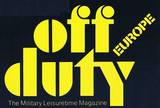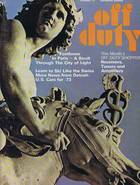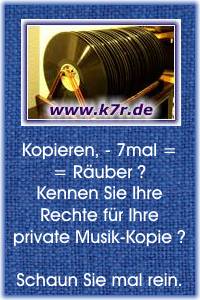"off duty" 1970 - 1997 - eine Freizeit-Zeitung für's US-Militär
Die in diesem amerikanischen (Freizeit-) Shopping-Magazin angepriesenen Hifi- und Video-Produkte waren auschließlich amerikanischen und kanadischen Militärangehörigen zugänglich - also zu kaufen - und vor allem zu ganz ungewöhnlich (verblüffend) niedrigen US $ Military-Preisen. Zu der einführenden "off duty" Seite geht es hier lang. - Um 1970 begann der weltweite Hifi-Boom bis zum 1. Crash 1978 und dann wieder zum 2.Crash um 1990. Über die 20 Jahre nach 2001 lesen Sie mehr in den Kolumnen auf diesen japanischen Seiten.
.
Die 1972er Auflistung der gigantischen Hifi- "Produktfülle"
von Gert Redlich im Oktober 2020 - Wie bereits ausgeführt, wir Jungspunde und Hifi-Freaks oder -Fans waren nicht nur beeindruckt sondern auch hungrig und wissensdurstig, was es alles gab und wieviele Spitzengeräte Monat für Monat dazu kamen.
Wir sind hier zurück im Oktober 1972 - Irgendwie war das irre oder gigantisch und schon nicht mehr zu überschauen. Wir staunten nur noch, wie "kreativ" und auch innovativ die Japaner waren und wie sie den gesamten Audio- Welt-Markt aufrollten. Wir machten uns damals überhaupt keine Gedanken über den gnadenlosen Wettbewerb auf dem Weltmarkt sowie den Leidensdruck, der hinter den Kulissen mit allen mehr oder weniger legalen Mitteln der Marktwirtschaft tobte.
Alleine Akio Morita (der SONY Vice-Chef) hatte das in seinem Buch sehr anschaulich beschrieben. Wenn SONY eine Innovation auf dem Weltrmarkt erfolgreich durchgezogen hatte, kamen etwa 1 Jahr später hunderte von mächtigen "Trittbrettfahrern" oder Heuschrecken (aus dem eigenen Land !!!), die nicht nur "etwas" von dem Kuchen abhaben wollten, nein, sie wollten den gesamten Kuchen haben. Somit hatte SONY auch Leidensdruck und Zeitnot.
"annual survey" - (zu bezahlende) jährliche Marktübersicht
.
Audio Abundance
Off Duty I Europe / October 72 - This Month's Shopper - By THOM PRINGLE
The 1972 selection of receivers, tuners and amplifiers is the biggest most impressive ever.
.
WHO SAYS THE GOOD GUYS don't win?
For years some major manufacturers and professional industry watchers have been begging for upgrading of equipment and better statements of performance.
Now, it looks as if the day has arrived. Of course, 4-channel is still a hot issue, but one of the most satisfying developments during the past year has been the trend of manufacturers to not only give more complete specifications, but to actually introduce completely new lines with "full-frequency" performance.
Endlich aussagefähige RMS Nennleistung
The entire idea of better-defined performance means that there is less question as to how a piece of equipment will perform. It has been the practice of many manufacturers to state their power rating at one frequency (1 kHz) which was hardly representative of the 20 to 20,000 Hertz audio band.
Now, however, the trend is to give power ratings over the entire range of audio frequencies with a given amount of distortion. If you have the opportunity to compare an amplifier which has been rated both ways, you will be able to appreciate this change.
For instance, some amplifiers which are rated at 75 watts per channel with the 1kHz method (over 200 watts with the "dynamic" method) can actually produce only 50 watts per channel with the full frequency method.
In addition, because of power supply limitations, many amplifiers cannot produce as much power when operated with both channels activated as they can when only one channel is operated. This, again, is one of the new ratings being used by many manufacturers who realize that most people operate both (or all four) channels when using their hi-fi systems.
When you are looking at the models offered, you will find some manufacturers who have introduced entirely new lines which are specifically geared to produce full-frequency power. Others will have restated their specifications for existing equipment and still others have been stating full-frequency performance for years. And there are a few who have chosen to stay with the old single-frequency rating method. We'll talk more about specifications and power ratings in our specific recommendations later.
.
Neue Trends und viele neue Produkt-Linien
Another noticeable trend is the increased complexity of features offered on new receivers, especially control circuits for external devices such as 4-channel adapters, noise reduction units and equalizers.
The number of jacks on the back of the newer units is sometimes staggering (especially if the unit happens to be a 4-channel unit). Most of the manufacturers want to make sure that the unit you buy will not soon be outdated, so they are including a detector output jack from the FM tuner section to be used for a 4-channel broadcast decoder whenever a standard system is developed.
They may also include tape monitor circuits for as many as three 4-channel tape decks. Output and input jacks for a noise reduction unit will make the back panel of your unit look even busier. Then toss in two or three sets of 4-channel speaker connections and the assorted normal input jacks and you can see what we mean. But, it's all done because 'the manufacturers have found out that audiophiles are more demanding than ever - especially military audiophiles who are the most demanding of all.
Es ist 1972 und QUADRO ist "in"
Naturally, 4-channel is in the news, too, and while there are still many questions about 4-channel, the picture is beginning to stabilize a bit and you'll see this reflected in the newer models in our SHOPPER. Here are some of the specific features you may notice:
4-channel broadcast decoder jacks. These are jacks located on the back panel of the tuner or receiver which will accommodate an external device to decode 4-channel broadcasts whenever a final system is agreed upon. This is a bit of insurance since it is possible that stations may simply use a matrix system which can be decoded with your built-in matrix decoder.
Built-in matrix decoders.
For simplicity, we have labeled two types of matrix decoders, regular and SQ. There are definite differences between the two and you should really have the same type decoder as the material you are trying to decode. Several companies, however, have brought out "universal" decoders which are said to decode both types of matrix material and you'll see these included in some receivers.
Some of those units without universal decoders will have both a regular matrix decoder and an SQ decoder, while others may have a regular decoder with jacks for an external SQ matrix decoder. The point is that you can come up with a system that will decode whatever kind of matrix material you may have if you are careful in your selection.
JVC's CD-4 system
Discrete 4-channel discs. JVC's CD-4 system which uses a subcarrier has not been included in many units, but can be easily added to almost any installation. So, you need have no hesitation about your system being outmoded by future popularity of CD-4.
High-level decoders.
These are the 4-channel matrix decoders that are tacked on the output of a stereo amplifier and produce 4-channels at high power levels.
Therefore, you will see several units in our SHOPPER which have only two amplifier channels yet claim to produce genuine 4-channel sound - they do. And effectively, too. But be careful to see that the unit you are considering actually has the decoder and is not offering simply four speakers connected in two stereo pairs. Remember, too, that stereo amplifiers with high-level decoders cannot handle discrete 4-channel material as can units with 4-channel amplifiers.
4-channel amplifiers.
Most of the 4-channel units in our SHOPPER have four separate amplifier channels and are marked as such. This means that they can handle either discrete 4-channel material or decoded matrix material.
.
4-channel simulators.
Several units in our SHOPPER have circuits which can enhance stereo material by feeding portions of the material to the rear speakers thereby giving a 4-channel effect. This may be accomplished with a delay circuit, by separating out-of-phase signals for the rear channels or by frequency differentiation. In any case, remember that this is not matrix nor discrete 4-channel, but simulated 4-channel.
For further advice concerning moving into 4-channel, see the accompanying article about the "4-channel dilemma." Meanwhile here are some facts you should keep in mind about all types of receivers, tuners and amplifiers.
RMS Power.
The most complete specifications for amplifier outputs shows the RMS power when the amplifier is driven into an 8 ohm load with all channels operating without exceeding a given amount of distortion at any or all audio frequencies.
Some amplifiers will be rated with only one channel operating which generally means that they can produce more power, as is the case when the amplifier is rated only at a midrange frequency.
A full-frequency, full-operation specification might read, "RMS power output 33 watts per channel into 8 ohms at all frequencies with 0.5 per cent harmonic distortion, both channels operating."
This description covers just about all the variables (with the exception of line voltage) and is an excellent start toward choosing an amplifier. You will note that many units omit one or more of the factors in the preceding description and, while this does not mean that the unit is inferior, you might want to take a more conservative view of the specifications given for the unit.
Frequency response.
A good amplifier covers the audio spectrum with a minimum of variation. In other words, at a given amount of power it should amplify all frequencies equally-within one or two decibels (±1 dB).
Frequency response is usually measured at normal listening levels, which under average conditions is about one or two watts. At higher power levels, a really "flat" response is more difficult to achieve and such an amplifier is likely to cost more. Here again is where the full-frequency power rating is important.
IHF power bandwidth
This measure follows standards set up by the Institute of High Fidelity (IHF). It represents the range of frequencies over which the amplifier can deliver at least 50 per cent of its rated power. "Half power," incidentally, is a reduction of just 3 dB with sharp peaks at some frequencies and dips in the response curve at another frequencies. So the amplifier's power bandwidth of, say, 20-30,000 Hz, and its low-level frequency response curve (ideally, within 2 dB throughout the audible range) are tell-tale indicators as to its performance.
Distortion
The distortion figures tell whether an amplifier does anything to the signal other than amplify it. Usually, both harmonic distortion (THD) and intermodulation (IM) distortion are given. Figures lower than one per cent are considered acceptable. For a truly meaningful rating, look for harmonic distortion measurements at more than one frequency. Like the power rating, the spec is likely to be more impressive at a mid-frequency than at the extremes of the audio spectrum.
Hum and noise
All amplifiers add signals of their own to your input signal. You can hear this by turning up the volume control on your amplifier without putting any signal into it. The hum and noise specification tells you how much extraneous sound the amplifier produces in relation to the output signal. Look for a rating of at least -60 dB and an even better -70 dB rating if you plan to do a lot of tape recording. Make sure that the rating is taken through the phono input and therefore includes the preamp (where most of the noise is added).
FM tuners
FM tuner specifications are concerned mostly with its sensitivity and its ability to produce a good audio signal. A sensitivity figure of 1.8 uV (IHF) means that the receiver must have a radio signal of at least 1.8 microvolts to produce an audio signal which is reasonably above (+30 dB) any ancillary noise. In actuality, few audiophiles spend time crawling around in the atmospheric underbrush hunting for microscopic signals. So, if you see that a tuner has an IHF sensitivity of two microvolts or less, be assured that it has good sensitivity and move on to consider the signal-to-noise ratio.
Signal-to-noise (S/IM) ratio
With sensitivity, we are measuring very weak signals, but don't know how well the set performs when it has a good, hefty signal. You learn that by reading the S/N ratio. It tells you that the set in question, given a strong radio signal, will produce an audio signal so many dB above any accompanying noise. Look for a rating of at least 60 dB; 70 dB or better is outstanding.
Stereo separation
This figure tells how well the tuner's multiplex (stereo) circuit is working, and how much difference there will be between the right and left channels. The separation is almost always given at a reference frequency of 400 Hz or 1 kHz. Look for a figure of 35 dB or higher.
Harmonic distortion
In FM tuners, follow the same principles applied in amplifiers - under one per cent THD is acceptable. Be aware that distortion is higher in stereo reception than in mono, so when making comparisons always consider the same mode of operation.
Alternate channel selectivity and capture ratio
These specifications tell you how effectively the tuner separates the many stations on the dial. To prevent interference from stations broadcasting next to the station you want, a receiver should have a selectivity figure of not less than 40 dB.
And to suppress signals from more distant stations on the same channel, the tuner should have an IHF capture ratio of less than 3 dB. Most manufacturers use sensitive Field Effect Transistors (FETs) in the front-end (antenna input stage) of their FM tuners and special filters in the IF (intermediate) stages, and it is the development of these sophisticated new circuits that has made possible today's high-performance tuners. Some models now employ diode tuning, a newly developed system that does away with the old tuning capacitor, replacing it with voltage sensitive diodes. The main advantage is convenience, for diode tuning permits electronics remote control and automatic scanning of the FM dial.
Price.
With the more complete specifications it is easier than ever to see what your money is buying. One thing, however, which you can't tell unless you're a trained technician is the amount of longevity built into a unit through careful design and high quality.
About all you can do is rely on the manufacturer's reputation, the advice of a trusted technician and, perhaps, independent test reports. In most cases, you'll find that those units recommended for long-term quality are also the more expensive units - so, you're trading dollars for longevity.
Special features.
As in all equipment, each manufacturer has his own unique features and this is one of the most interesting parts of selecting a newunit. Many of the new 4-channel models have a joystick remote-control unit to let you smoothly control all four channels simultaneously without getting up from your easy chair.
We've already mentioned the variety of input and output connections, with the external junction between the preamp and power amp now being fairly common.
Several tuners have digital readouts instead of the usual dial and pointer, and one late model has a built-in Dolby processor for Dolbyized FM broadcasts. Several amplifiers (and receivers) have frequency equalizers to give you precise tone control.
Our SHOPPER this year has (1972), we feel, the largest, most varied and highest quality selection of receivers, tuners and amplifiers we've ever presented. And, with those attractive military discount prices, you're a virtual kid in a candy store - with unlimited credit.
.
.



